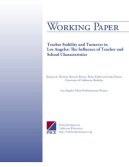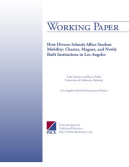 | PACE LAUSD STUDY: Teacher Stability and Turnover in Los Angeles |
 | PACE LAUSD STUDY: How diverse schools affect student mobility |
LA charter schools see high teacher churn
By CHRISTINA HOAG Associated Press/from the San Jose Mercury-News | http://bit.ly/oU4fle
07/19/2011 11:59:37 AM PDT - LOS ANGELES—Teachers at Los Angeles Unified charter schools are up to three times as likely to quit their jobs as their counterparts in traditional district schools, according to a University of California, Berkeley study released Tuesday.
Teachers at charter high schools in high-poverty neighborhoods are particularly likely to leave their schools—40 percent as compared to about 18 percent in regular inner-city high schools, according to the study, which was presented to LAUSD officials
Study co-author Xiaoxia Newton, an assistant education professor, called the inner-city charter turnover rate "alarmingly high" and noted that it likely stems from difficult teaching conditions.
Charter school teachers often have to grapple with students entering with very low academic skills and an evaluation system based on standardized test scores, which may not show student improvement because the student started at such a low level and will take several years to reach grade level.
"The demands of the job are much higher in these schools," she said. "It's easy to get burned out."
Elementary charter teaching staffs were more stable, but still more likely to quit than traditional-school teachers—22 percent as compared to about 17 percent, the study found.
The study analyzed seven years' worth of teacher retention data reported by about two-thirds of LAUSD charter schools to the district from 2002 to 2009. LAUSD has nearly 200 charter schools, the highest number of public, independent schools in the nation.
Charter school advocates noted that the study does not present a complete picture of charter school staffs because independent charters are not required to report staffing to the district. Most of LAUSD's charters are autonomous startups; the remainder are affiliated with the district.
"This is very heavily skewed to affiliated and converted charters," said Myrna Castrejon, senior vice president of the California Charter Schools Association. "It masks a lot of the bigger stories."
Castrejon added that her organization would encourage autonomous charters to report their staffing data in the future.
In a separate study also released Tuesday, researchers found charter school students to be more loyal to their campuses—up to 80 percent of students were less likely to leave than students at regular schools.
Study co-author Luke Dautner said the quality of facilities played a key role in keeping students. Students attending a new traditional high school were almost one-third less likely to leave than students at older schools. Magnet schools also had high student retention rates.
Latino students and teachers were less likely to switch schools than African-Americans, the study said.
Study: Teacher turnover much higher at LA charters than public schools
Adolfo Guzman-Lopez | KPCC | http://bit.ly/nwGwL2
July 19, 2011 | A new study released Tuesday finds that teacher turnover at Los Angeles charter schools is nearly three times higher than in the district's traditional public schools. The findings contribute to the current debate over teacher effectiveness.
Teachers leave schools for personal and professional reasons. At traditional L.A. Unified schools, teacher turnover hovered at about 15 percent during a recent six-year period, says UC Berkeley scholar Xiaoxia Newton.
At charter schools, she adds, it was about 40 percent. "One of the implications is that with nowadays' teacher evaluation and accountability and also teacher development focus, if we have such a mobile teaching force, how are we going to calculate value-added?"
That’s the new teacher evaluation method that’ll likely be part of L.A. Unified’s major overhaul of the way it evaluates and retains teachers.
Some teachers leave because they’re not cut out for teaching, Newton says, while others are good teachers who hit the burnout wall because of the seemingly endless demands at charter schools, including more hours. She suggests that’s too bad, because with the right support and professional development those good teachers could become great. Turnover is also higher among white teachers compared to minority teachers.
UC Berkeley’s Bruce Fuller oversaw the research. "We have seen earlier results showing that working conditions are tough and challenging in charter schools," says Fuller. "Charter teachers wear many hats and have many duties and are teaching urban kids, challenging urban kids, but we were surprised by the magnitude of this effect."
Fuller says that charters do "breed a lot of loyalty among parents and students, so the students are sticking around, the parents are committed to charter schools throughout L.A." Fuller says that teacher turnover "cuts into relationships. These parents and kids, by and large, expect to have strong links to these committed teachers. For whatever reason these teachers are leaving and that's going to undercut the motivation of kids and the commitment of parents."
L.A. has independent charter schools, but also Charter Management Organizations like Green Dot, which manage lots of campuses and become de facto school districts.
Turnover at schools in the 4,500-student ICEF Public Schools network in Los Angeles ranges from about 10 percent to 50 percent, says its recently-appointed chief executive, Parker Hudnut.
"Turnover is something that we’re absolutely focused on, to make sure that we keep the teachers we need to keep," says Hudnut, "but it’s very important for us to focus on keeping, to use a quote from Jim Collins, 'keep the right people on the bus.'"
Hudnot says that some turner is a good thing, with people looking different jobs or moving out of the area. "The question is what is the magical value of appropriate teacher turnover." ICEF runs 15 schools in and around L.A.
L.A. Unified includes the highest concentration of charter schools in the state. The UC Berkeley study is the first to examine teacher turnover in a sample of the district’s 163 charter schools.
Researchers chose L.A. Unified charters because it offered a large sample size. LAUSD is an epicenter for charters, with 163 in the district and 67,000 students. The district's also been home to big money supporters of charters, much debate about policies and clashes with critics like the teachers union.
Kate Beaudet’s been an L.A. Unified teacher for 16 years except for one year in which she taught at the Accelerated School, a charter campus in L.A. She liked the ability to deviate from the district’s scripted reading program but didn’t think management provided much support to teachers.
"We were not unionized and that was a huge thing," says Beaudet, "which I didn’t realize at the time how much my union meant to me until I was at this charter school, and that is huge. Now it happens to be unionized, many charter schools are."
Beaudet explained what not being unionized meant. "Having no representation, and then on top of it, most charters have these year-to-year contracts where you’re essentially an at-will employee, and for any reason whatsoever they can rescind your contract or they can just not offer you one, and they do not have to offer you a reason."
Los Angeles charter schools have high teacher turnover
Howard Blume - LA Times/LA Now | http://lat.ms/qkf8Ij
July 19, 2011 | 6:16 pm - Local charter schools serving middle and high school students are losing about half their teachers every year, according to a study of the Los Angeles Unified School District released Tuesday. The rate of turnover is nearly three times that of other public schools, although they also are seeing high rates of departures.
The picture is different for students, although less conclusive: If they attend a charter school, they are more likely to remain there than students in a traditional public school. Magnet schools are even better at retaining students.
The conclusions are based on data from the Los Angeles Unified School District as part of two companion UC Berkeley studies -- one on teachers and the other on students.
The findings about teachers are especially noteworthy, said study co-author Bruce Fuller.
“Earlier research shows that student achievement rests in part on strong, sustained relationships with teachers,” Fuller said. “High teacher turnover rates, at the eye-opening levels we discovered, are worrisome.”
This research does not address why teachers left or how this affected students. Many charters have posted strong results on state tests.
Charters are independently operated schools exempt from some rules that govern traditional schools, including union work rules. Magnets are special programs initially designed to promote voluntary integration; teachers at magnets work under standard district rules.
The California Charter Schools Assn. said the studies examine important issues but questioned whether their findings derive from a true cross-section of charters. L.A. Unified has more charter schools than any school district in the country, about 10.5% of total enrollment in the nation’s second-largest school system.
The researchers said the data on instructors is broadly representative because nearly all charters report teacher data to L.A. Unified or the state. The findings on students are somewhat less representative, because fewer charters report that information.
In the 2007-08 school year, the most recent in the six-year study, 45% of charter secondary teachers-- those in middle and high schools -- had exited before the next school year. The range of annual departures was 41% to 55% over that period. The range for other public schools was 14% to 23% over that period.
Charters fared better on the study of student enrollment. For the 2007-08 school year, about 2% of students left a magnet school, about 4% left a charter school, about 5% left a newly constructed school and about 6% left all other schools. These are not dropout rates, but rather an indication of what percent of students left a particular school for any reason.
One purpose of the study was to see if L.A. Unified’s $20-billion new school construction program reduced student departures. Over the six years of the study, student turnover was slightly lower overall in the new schools.
The studies were supported with $110,000 in grants from the New York City-based Ford Foundation, the Menlo Park-based Hewlett Foundation and the Spencer Foundation in Chicago. L.A. Unified contributed staff resources and data.
PACE LAUSD STUDY: Teacher Stability and Turnover in Los Angeles PACE LAUSD STUDY: How diverse schools affect student mobility

No comments:
Post a Comment